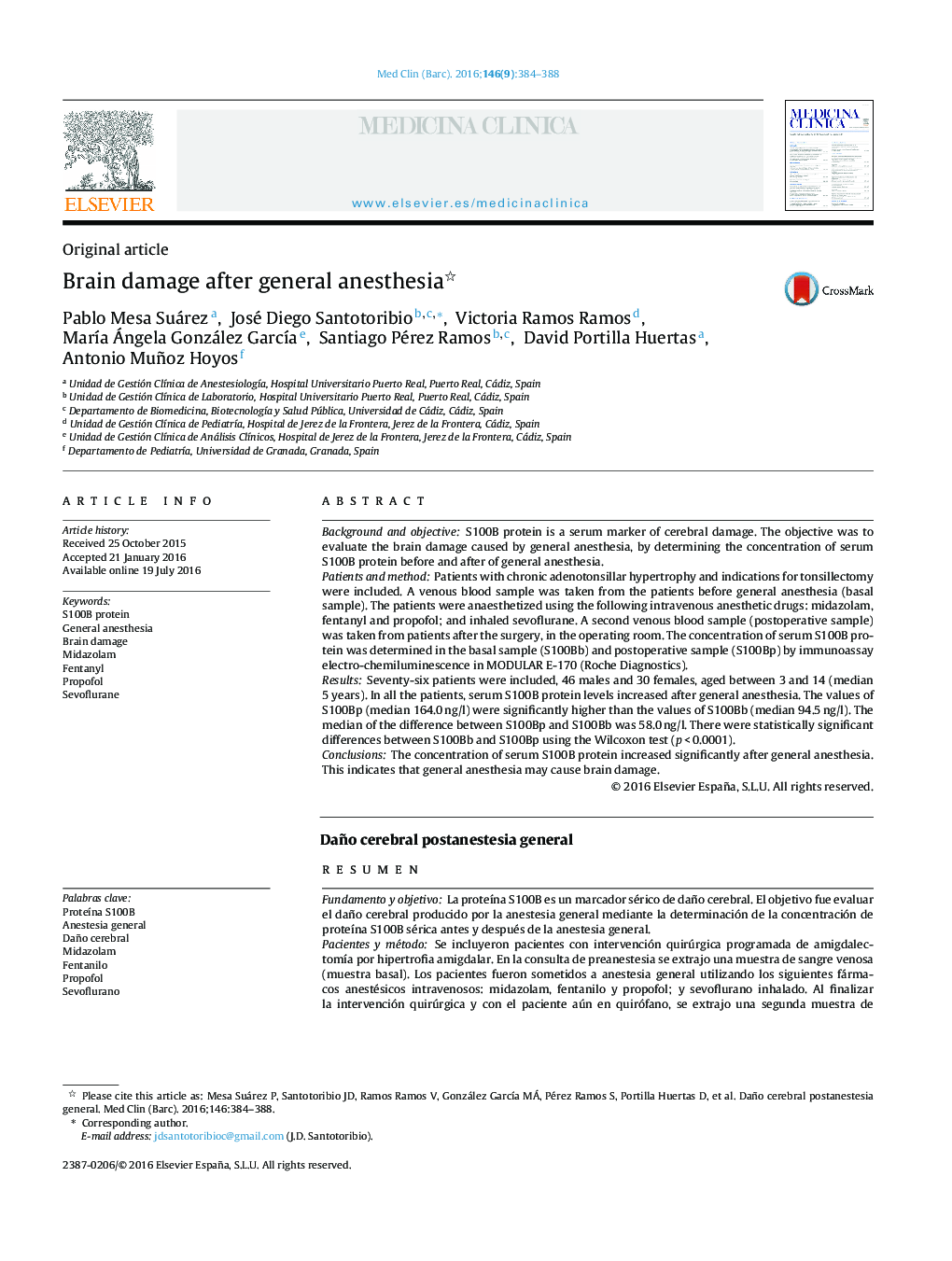| کد مقاله | کد نشریه | سال انتشار | مقاله انگلیسی | نسخه تمام متن |
|---|---|---|---|---|
| 3806153 | 1245276 | 2016 | 5 صفحه PDF | دانلود رایگان |
Background and objectiveS100B protein is a serum marker of cerebral damage. The objective was to evaluate the brain damage caused by general anesthesia, by determining the concentration of serum S100B protein before and after of general anesthesia.Patients and methodPatients with chronic adenotonsillar hypertrophy and indications for tonsillectomy were included. A venous blood sample was taken from the patients before general anesthesia (basal sample). The patients were anaesthetized using the following intravenous anesthetic drugs: midazolam, fentanyl and propofol; and inhaled sevoflurane. A second venous blood sample (postoperative sample) was taken from patients after the surgery, in the operating room. The concentration of serum S100B protein was determined in the basal sample (S100Bb) and postoperative sample (S100Bp) by immunoassay electro-chemiluminescence in MODULAR E-170 (Roche Diagnostics).ResultsSeventy-six patients were included, 46 males and 30 females, aged between 3 and 14 (median 5 years). In all the patients, serum S100B protein levels increased after general anesthesia. The values of S100Bp (median 164.0 ng/l) were significantly higher than the values of S100Bb (median 94.5 ng/l). The median of the difference between S100Bp and S100Bb was 58.0 ng/l. There were statistically significant differences between S100Bb and S100Bp using the Wilcoxon test (p < 0.0001).ConclusionsThe concentration of serum S100B protein increased significantly after general anesthesia. This indicates that general anesthesia may cause brain damage.
ResumenFundamento y objetivoLa proteína S100B es un marcador sérico de daño cerebral. El objetivo fue evaluar el daño cerebral producido por la anestesia general mediante la determinación de la concentración de proteína S100B sérica antes y después de la anestesia general.Pacientes y métodoSe incluyeron pacientes con intervención quirúrgica programada de amigdalectomía por hipertrofia amigdalar. En la consulta de preanestesia se extrajo una muestra de sangre venosa (muestra basal). Los pacientes fueron sometidos a anestesia general utilizando los siguientes fármacos anestésicos intravenosos: midazolam, fentanilo y propofol; y sevoflurano inhalado. Al finalizar la intervención quirúrgica y con el paciente aún en quirófano, se extrajo una segunda muestra de sangre venosa (muestra postexposición). Se determinó en suero la concentración de la proteína S100B en la muestra basal (S100Bb) y en la muestra postexposición (S100Bp), mediante inmunoanálisis de electroquimioluminiscencia en el MODULAR E-170 (Roche Diagnostics).ResultadosSe incluyeron 76 pacientes, 46 varones y 30 hembras, con edades entre 3 y 14 años (mediana 5 años). En todos los pacientes, los niveles de proteína S100B sérica aumentaron tras la anestesia general. Los valores obtenidos de S100Bp (mediana 164,0 ng/l) fueron significativamente mayores que los obtenidos de S100Bb (mediana 94,5 ng/l). La mediana de la diferencia entre S100Bp y S100Bb fue de 58,0 ng/l. Mediante el test de Wilcoxon se encontraron diferencias estadísticamente significativas entre S100Bb y S100Bp (p < 0,0001).ConclusionesLa concentración de proteína S100B sérica aumentó significativamente tras la anestesia general. Esto indica que la anestesia general puede producir daño cerebral.
Journal: Medicina Clínica (English Edition) - Volume 146, Issue 9, 6 May 2016, Pages 384–388
